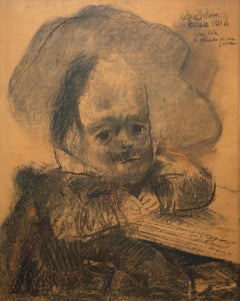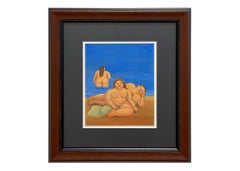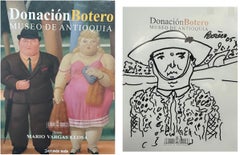Fernando Botero Figurative Drawings and Watercolors
Fernando Botero Angulo was a Colombian figurative artist and sculptor, born in Medellín in 1932. His signature style, also known as "Boterismo," depicts people and figures in large, exaggerated volume, which can represent political criticism or humor, depending on the piece.
Botero was for years considered the most recognized and quoted living artist from Latin America, and his art can be found in highly visible places around the world, such as Park Avenue in New York City and the Champs-Élysées in Paris.
Self-appointed "the most Colombian of Colombian artists" early on, Botero came to national prominence when he won the first prize at the Salón de Artistas Colombianos in 1958. He began creating sculptures after moving to Paris in 1973, achieving international recognition with exhibitions across the world by the 1990s. His art is collected by many major international museums, corporations, and private collectors.
In 2012, Botero received the International Sculpture Center's Lifetime Achievement in Contemporary Sculpture Award.
Find original Fernando Botero sculptures, prints and other art on 1stDibs.
(Biography provided by Nohra Haime Gallery)
Mid-20th Century Post-War Fernando Botero Figurative Drawings and Watercolors
Cardboard, Charcoal, Pastel
1960s Fernando Botero Figurative Drawings and Watercolors
Pencil
21st Century and Contemporary Contemporary Fernando Botero Figurative Drawings and Watercolors
Pastel, Charcoal
19th Century Modern Fernando Botero Figurative Drawings and Watercolors
Pencil
20th Century Post-War Fernando Botero Figurative Drawings and Watercolors
Watercolor, Paper
Late 20th Century Modern Fernando Botero Figurative Drawings and Watercolors
Pastel, Charcoal
20th Century Modern Fernando Botero Figurative Drawings and Watercolors
Paper, Pencil
19th Century Academic Fernando Botero Figurative Drawings and Watercolors
Paper, Chalk, Pencil
19th Century Old Masters Fernando Botero Figurative Drawings and Watercolors
Pencil
Early 20th Century Modern Fernando Botero Figurative Drawings and Watercolors
Charcoal, Pastel
1930s Expressionist Fernando Botero Figurative Drawings and Watercolors
Paper, Charcoal, Graphite
1970s Post-War Fernando Botero Figurative Drawings and Watercolors
Paper, Gouache, Charcoal
Mid-20th Century Modern Fernando Botero Figurative Drawings and Watercolors
Watercolor, Pencil
Mid-20th Century Post-War Fernando Botero Figurative Drawings and Watercolors
Mixed Media, Paper
20th Century Modern Fernando Botero Figurative Drawings and Watercolors
Watercolor
Early 2000s Contemporary Fernando Botero Figurative Drawings and Watercolors
Permanent Marker
Fernando Botero figurative drawings and watercolors for sale on 1stDibs.
- 1stDibs ExpertFebruary 1, 2024Fernando Botero is famous for his signature artistic style, which depicts people and figures in large, exaggerated sizes and conveys political criticism or humor, depending on the piece. Botero came to national prominence when he won the first prize at the Salón de Artistas Colombianos in 1958. He began creating sculptures after moving to Paris in 1973, achieving international recognition with exhibitions across the world by the 1990s. His art is collected by many major international museums, corporations and private collectors today. Shop a selection of Fernando Botero art on 1stDibs.
- 1stDibs ExpertApril 5, 2022Fernando Botero was an artist known for his satirical artwork. His ‘Mona Lisa, Age 12’, a parody of Leonard DaVinci’s magnum opus, shot him to fame in 1959. Shop a selection of Fernando Botero pieces from some of the world’s top art dealers on 1stDibs.




